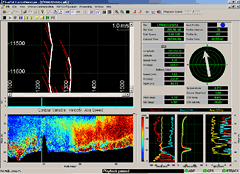

 | |||||||
|
|
Journals 2004/2005Leesa Wingo
July 17, 2004 We were going to start at 6:30 but changed to 7:00, due to timing our sampling with the low tides. We headed to the southern part of Willoughby Island to sample under water currents using the Acoustic Doppler Current Profiler (ADCP) and the CTD. The plan was to test the flood (incoming) tide, then the slack (high or low) tide in mid-channel. (Opposite of flood tide is ebb or outgoing tide.) Before we even started, we had to pause 30 minutes while a Princess Cruise Ship drove right through the middle of the sampling area. Science waits for behemoths, especially when the head ranger of Glacier Bay gives us the 'prime directive' to yield to all tour ships.  While we waited I saw sea otters with pups and seals that looked like ocean low-riders, barely peeking out of the water on their nosey surveillance. One whale breached off in the distance, then slapped its fin repeatedly near the shoreline. The first transect was stopped early because the current was so strong, we couldn't make any headway at a speed the equipment could register information. A large red blob appeared on the ADCP computer monitor, indicating a current increase in deep water, while we were taking a CTD cast at 11:10. Lisa was excited to see the appearance of the blob. (Click on thumbnail below for full version pop-up) At 11:13, the surface CTD blew off its water intake hose, so salinity dropped from 22-0 ppt. This will show an odd salinity reading, so Erica records every incident that occurs on board on the data sheets so they will remember back in the office why some of their values read as they do. We hooked it back on, and started it up again. On the second transect, we headed from up bay towards the entrance and crossed the front line. Our speed started at 3.6 knots, but after hitting the current, we were immediately slowed by the ebbing tide to 1.6 knots. We were almost at the furthest north limit of the Front line. The Front line looks like a big S, which we crossed several times. At the top, the line smears out to an indistinguishable smudge with not much differentiation. Salinity is 21 ppt. We found that the line isn't as noticeable in ebb tide as it was in Flood tide. Also, ADCP is not always reading bottom depth. It may be due to some strange layering in the water causing the ADCP to not let the signal bounce off bottom. Could this be similar to subs in WWII hiding in different salinity/temperature densities of water so they wouldn't get "pinged" by the Nazis, so the sonar would bounce off the layers? Later Lisa found out that it a calibration parameter adjustment correction in the computer program would fix this. Back and forth across the line we saw the salinity jump from 22 to 27 ppt. The line wasn't easy to see, and our speed was slowed by the current's influences. Lots of birds, fish and whales are hanging out here at the frontal zone. The plankton is so thick you can see it just by gazing into the water. Capelin jumping all over the area, bigger silver fish launch themselves, birds crash land, whales popping out of the water and playing whenever possible, and otters feasting, wrapped in kelp comforter. By the end of the day, Lisa had more questions...
It is fascinating to see how questions, hypotheses, and research breed more questions. Return to Journals Index |
||||||
